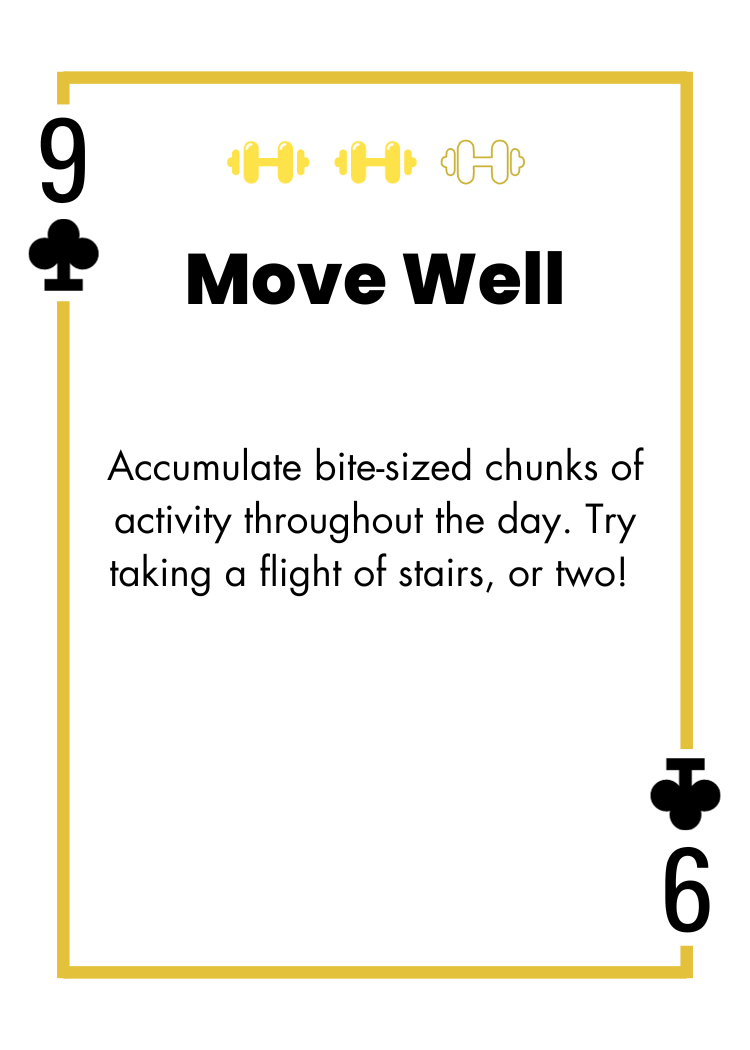9 of Clubs - Flight of Stairs

It’s easy to take a shortcut, ride the escalator, take the lift, right?
But, if you go the scenic route and take the stairs instead you’ll not only boost your step count and raise your heart rate, but you’ll feel great too! Whether your goal is running a marathon or walking up the stairs, it all starts with the first step.
If you’d like more manageable and achievable tips like that, specific to your lifestyle and goals, sign up for wellness coaching with our experts today. Our physical activity experts can help you integrate movement into your everyday. Exercise doesn’t have to be a chore – let us guide you, 1% at a time.

Stair climbing involves scaling either walking up or running up flights of steps. Stairs can be used as type of everyday activity, exercise, or sport. Stairs include house or office building stairwells, park stairs or the use of a stair climbing machine to simulate walking up stairs. Warm up beforehand, start out slow and progress slowly over time (Migala 2023).
If you would like assistance in learning how to excel at stair climbing exercises, contact one of Imago’s qualified fitness wellness coaches today!
Stair climbing challenges other muscles than from just walking on flat ground. The legs use the gluteus maximus, hamstrings and calves to climb stairs. These muscles extend the hip as you ascend the stairs. If you want to tone your glutes (butt) taking the stairs will help (Bumgardner 2020).
Using stairs is inexpensive and can be easily integrated into everyday life by most of the population. Stair climbing can be a vigorous intensity physical activity (high heart rate) with oxygen uptake reaching approximately 80% of maximal values in young healthy adults. Several studies suggest stair climbing is effective in improving aerobic capacity and the risk of cardiovascular (heart and blood vessels) disease (Meyer et al., 2009).
In a study by Meyer et al, 2010, the authors conducted a promotion simulation of stair use at population level by evaluating the potential cardioprotective effects of a worksite promotional campaign of stair use in employees at the University Hospital of Geneva. Participants were encouraged to use stairs instead of elevators during a 12-week hospital-wide promotional campaign for stair use using positive messages on posters positioned at the ‘point- of-choice’ between stairs and elevators at each hospital floor.
During the 12 weeks of the authors’ study, median (middle number of daily data sets) daily ascended and descended one-story staircase units rose from 5 to 21 and estimated VO2max (oxygen uptake) increased by 9.2% corresponding to almost 1 MET (metabolic equivalent of task, a measure of exercise intensity). There was a significant decline in waist circumference 1.7%, weight 0.7%, fat mass 1.5%, diastolic blood pressure 1.8% and LDL (unhealthy) cholesterol 3.0%.
The authors’ study shows encouraging healthy adults to use stairs instead of elevators at work is effective in improving cardiorespiratory fitness by approximately 1 MET and in reducing cardiovascular disease risk factors such as waist circumference, unhealthy cholesterol and blood pressure.
https://www.verywellhealth.com/daily-stairs-for-a-healthy-heart-8349369
Small changes CAN make a big difference – that’s what the 1% club is all about.
Bumgardner, W. (2020, September 17). Taking the stairs can burn extra calories and keep you healthy. Verywell Fit. https://www.verywellfit.com/taking-the-stairs-3435081
Meyer, P., Kayser, B., & Mach, F. (2009). Stair use for cardiovascular disease prevention. European Journal of Cardiovascular Prevention & Rehabilitation, 16(2_suppl), S17-S18.
Meyer, P., Kayser, B., Kossovsky, M. P., Sigaud, P., Carballo, D., Keller, P. F., … & Mach, F. (2010). Stairs instead of elevators at workplace: cardioprotective effects of a pragmatic intervention. European Journal of Preventive Cardiology, 17(5), 569-575.
Migala, J. (2023, February 23). Stair climbing workouts: What it is, health benefits, and how to get started. EverydayHealth.com. https://www.everydayhealth.com/fitness/stair-climbing-workouts/guide/


 See Other Cards!
See Other Cards!